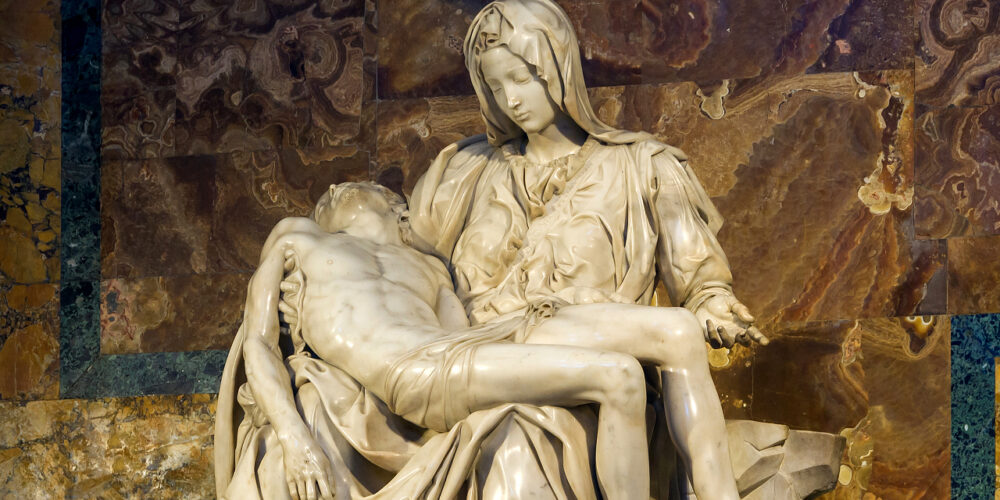Mary Ann Sures (1928–2020) was an art historian who lectured extensively, beginning in the early 1960s, on the application of Objectivist esthetics to the visual arts. She did graduate work in art history at the Institute of Fine Arts of New York University and at Hunter College, from which she received an MA. She taught art history at New York University (Washington Square College) and at Hunter College. She was coauthor with her husband, Charles, of Facets of Ayn Rand, a memoir of their longtime friendship with Ayn Rand and her husband, Frank O’Connor.
“Metaphysics in Marble” was originally published in Ayn Rand’s magazine The Objectivist (February and March 1969) and is recommended by Rand in The Romantic Manifesto. The original article contained no footnotes or images, relying instead on vivid descriptions of the sculptures discussed. The editors are pleased to publish it here in New Ideal with the author’s added footnotes. (In a few instances, written text accompanies these linked images; neither the editors nor the author endorses these texts, and they are not part of the article. In cases where links selected by the author have ceased functioning, the editors have inserted new links to images resembling the originals as closely as possible.)
Metaphysics in Marble
By Mary Ann Sures
Part I
“Art is a selective re-creation of reality according to an artist’s metaphysical value-judgments.” (Ayn Rand, “The Psycho-Epistemology of Art,” The Objectivist Newsletter, April 1965.)
Given the definition of art, one often hears the question of how metaphysical abstractions can be conveyed in a visual art such as sculpture.
This discussion is a brief historical survey to answer that question: to indicate the means by which sculpture expresses abstractions—and to demonstrate the connection between the dominant philosophy of a given era and its sculpture.
The history of sculpture is a history of man’s view of man—of his body and spirit, i.e., of his metaphysical nature. Every culture, from the most primitive to the most civilized, has held an estimate of man and has wanted to see the objectified reality of that estimate. Man has been the predominant subject of sculpture, whether he was judged to be an object of pride or of shame, a hero or a sinner.
A metaphysical view of man is projected by the manner in which the sculptor presents the human figure. In the process of shaping clay or wood or stone into the form of a body, the sculptor reveals his answer to three questions: Is man a being of free will or is he a helpless puppet of fate?—Is he good or evil?—Can he achieve happiness or is he doomed to misery—and then mounts his answer on a pedestal and puts it in a tomb or in a temple or over the portal of a church or in a living room in New York City.
The ancient Egyptian put his answer in a tomb or temple; both monuments symbolized his obsessive preoccupation with life after death. In a civilization saturated with magic and superstition, he worshiped gods in human, animal and monster form—gods who, he believed, controlled his destiny and whom he placated with sacrificial offerings. Moving haltingly through what he believed to be an incomprehensible universe, his every step accompanied by ritual prescribed by the priests, he built temples to the gods and tombs for the dead, he chanted hymns to the dead, offered food to the dead, said prayers for the dead—and then accepted payment for his efforts: he joined them.
This was the Egyptian’s concept of man’s nature and destiny: a mindless puppet with strings attached to hosts of deities who manipulated him through an unintelligible life, while beckoning him into a state of non-life. This is the view concretized in most Egyptian sculpture.
Throughout the centuries of Egyptian civilization, sculptors arranged the human figure according to the law of frontality, which divides the body vertically into symmetrical halves. Facing directly forward, with movement restricted to the forward step of the left leg, the body projected a state of rigidity and immobility. Observe that the law of frontality is also an established convention in the practice of undertakers.1
For every living entity, motion is a prerequisite for the achievement of the values that sustain its life. Man, who must initiate the process of thought required to identify and select his values, must also initiate the physical motion required to attain them. Whether it is the motion of writing a treatise or the motion of excavating for the foundations of a skyscraper, the act of bringing his values into reality requires both thought and movement.
The state in which man, while still alive, can initiate neither thought nor movement, is a state of coma. A close approximation of this state is embodied in most Egyptian sculpture. The application of frontality produced an appearance of arrested movement. The sculptor then incorporated other features which, in conjunction with frontality, indicated that the movement of the body could hardly continue: he carved thick ankles and wrists, which suggest an arthritic condition; he minimized the musculature, virtually eliminating it in the arms, barely indicating it in the legs; he placed the arms down, along the sides of the body, often locking them to the torso with a web of stone; he terminated the motionless arms with clenched fists, or, in seated figures, placed the hands on the thighs, palms down. The material was carved in such a way that it retained the quality of stone, of inert matter. The face was usually carved to match the body: motionless, showing neither pleasure nor pain, neither perception nor introspection—a face virtually devoid of expression, reflecting no awareness, no consciousness. The total result projects a state which is neither life nor death, but a grotesque combination of the two: a state of living death.
Ancient Greece tore away the heavy shroud of mysticism woven for centuries in murky temples, and achieved, in three centuries, what Egypt had not dreamed of in thirty: a civilization that was essentially pro-man and pro-life. The achievements of the Greeks rested on their confidence in the power of man’s mind—the power of reason. For the first time, men sought to understand the causes of natural phenomena, and gradually replaced superstition with the beginnings of science. For the first time, men sought to guide their lives by the judgment of reason, instead of resorting exclusively to divine will and revelation.
The Greeks built temples for their gods, but they conceived of their gods as perfect human beings, rejecting the cats, crocodiles and cow-headed monstrosities enshrined and worshiped by the Egyptians. Greek gods personified abstractions such as Beauty, Wisdom, Justice, Victory, which are proper human values. In the Greek religion, there was no omnipotent mystical authority and no organized priesthood. The Greek had only a vague idea of, and little interest in, an afterlife. His religious practice was, essentially, an affair of state; the gods were honored with civic rites and festivals. On the whole, in his private life, he was left free to think and to seek happiness on earth. To quote Sophocles: “Wonders are there many—none more wonderful than man. His the might that crosses seas swept white by storm winds . . . He the master of the beast lurking in the wild hills . . . His is speech and wind-swift thought.” (Quoted in Edith Hamilton, The Greek Way to Western Civilization, New York, New American Library, 1948, p. 46.) Observe the characterization of man in terms of his essential attribute: his capacity to think.
In its earliest phase, in the seventh century B.C., Greek sculpture showed the influence of the Egyptian style in its featuring of frontality, clenched fists and the left-foot-forward posture in standing figures. However, while relying on Egypt for these features, the Greek sculptor introduced a startling change, one which undoubtedly would have shocked the Egyptian, but which was to remain a characteristic of Greek sculpture from its beginning to its end. The Greek carved man naked.2
Throughout the thirty centuries of its history, nudity was rare in Egyptian art, and was usually reserved for children or slaves. To reveal the body of an adult was taken, by the Egyptian, as a sign of degradation. The featuring of the naked body in early Greek sculpture is a sign of a different estimate of man, which broke through the Egyptian stylistic conventions that the Greek had borrowed. That estimate is also revealed by other elements. The Greek began to make distinctions between the parts of the body, by carving subtle indications of the rib cage, the collarbone, muscles in the legs, and joints in the knees, wrists, ankles and elbows. The Greek sculptor was beginning to give his image of man the physical endowment that would enable man to take his first steps—just as, at the same time, Greek philosophers were beginning to take the first steps of thought. Reason, as a consciously defined concept, was born in ancient Greece.
The history of Greek sculpture from the seventh to the fifth century B.C. is a record in marble of the gradual development of the concept of man as a self-confident being, able to live. The subject matter was predominantly religious, consisting of representations of the gods. However, since the gods were representations of ideal men, it was man’s body that they glorified, and it was an affirmative view of the human spirit that their statues projected. Gradually, the Greek sculptor eliminated the Egyptian conventions of frontality and rigidity; he studied anatomy, in order to represent man realistically. He reached the day when he rejected the lifeless automatons of Egypt, just as he rejected the comatose state they expressed.
Whether representing gods or athletes, Greek sculptors strove to objectify their concept of ideal physical beauty. This passion for the ideal body led one sculptor of athletes, Polykleitos, to work as if he had devised a canon of proportions for the physically perfect male figure. The size of every part of the body was calculated according to a fixed ratio. Sculptors eliminated the accidental imperfections which an average man might happen to possess, and featured only those physical attributes which contributed to the image of a healthy, perfect and sensuous body.3
The potentiality of movement is evident in all Greek sculpture. Sculptors carefully articulated the joints and musculature, in recognition of the fact that no body can move without them. They distributed the body’s weight so that the figures were balanced, but not frozen into rigid positions. Consequently, the statues suggested the capacity to shift their weight and move easily.
A quality of life was achieved also by the manner of carving the surface texture. Sculptors created the illusion of flesh that was both firm and soft, emphasizing the subtle rise and fall of the skin as it moves over the complexity of the underlying skeletal and muscular structure. In this way, they stressed the sensuous aspect of the body.
When a sculptor created statues of goddesses clothed in loose gowns, he flaunted their bodies by carving the marble in the style called “wet drapery.”4 This term designates transparent, fragile cloth which appears to have been applied to a moist body. At every point of contact between the body and the garment, the cloth clings and reveals the body’s subtlest curves. When the Greek carved a female statue, he left no doubt of its femininity, dressed or undressed.
Nike, the goddess of Victory, was a favorite of the Greek navy, and wooden statues of Nike were mounted on the prows of ships. In a marble version, the famous Winged Victory of Samothrace, the goddess stands on the prow of a ship, as an embodiment of motion. Her figure rises in an upward-sweeping curve and thrusts forward to meet the forceful winds of open seas. Wind whips her fragile gown across her torso, revealing its vibrant sensuousness. Proud and courageous, she embodies the attitude with which the Greeks set out to sea.5
Few of the heads of classical Greek statues have survived; but those that have, convey one quality: serene awareness. A calm face with a smooth brow—a face with no sign of inner conflict—was the Greek ideal.6
An entirely different view of man dominated the medieval Christian civilization. Man, according to Augustine, is “crooked and sordid, bespotted and ulcerous.” Medieval mystics regarded man as an evil creature whose body is loathsome because it is material, and whose mind is impotent because it is human. Hating man’s body, they said that pleasure is evil, and virtue consists of renunciation. Hating this earth, they said that it is a prison where man is doomed to pain, misery, calamity. Hating life, they said that death and escape into some other dimension is all that man could—and should—hope for.
Man as a helpless and depraved creature, was the basic theme of medieval sculpture until the Gothic period, whether he was shown being pushed into Hell or accepted into Heaven.
Once again, a naked body was regarded as a sign of humiliation and was reserved for representations of Adam and Eve, and of the damned in Hell. Saints were dressed, their shapeless bodies hidden beneath heavy garments. But, whether man was represented naked and damned or dressed and blessed, hatred for the body permeated every inch of the sculptured stone.
The medieval sculptor faced the problem of making the body recognizable as a material entity while, at the same time, depriving it of its material attributes. He solved the problem by dematerializing the body in a number of ways. Although sculpture is a three-dimensional medium, the medieval sculptor presented the body primarily as a two-dimensional unit: he flattened it out, so that it retained its attributes of height and width, but very little of its third dimension. Free-standing sculpture (i.e., a figure carved on all sides) rarely appeared in Egypt; it was a typically Greek phenomenon. It was practically non-existent in medieval sculpture prior to the thirteenth century. Instead, the thin, weightless bodies remained attached to the stone from which they were made. The arms were often drawn in to rest against the chest or sides of the torso, so as not to project into the surrounding space. When carving a seated figure, the sculptor often pushed the thighs and knees out to the sides of the body, compressing it into a two-dimensional plane. Thus the figures were dematerialized and confined to narrow spatial areas. The human body, apparently, was not to be allowed an earthly reality.7
One of the first features to reappear in medieval art was the law of frontality, along with the effect of immobility. As a rule, when a body was shown in a moment of action, the movement was not natural. The figure was shaped into a twisted, contorted position which would be possible only with broken limbs and disconnected joints. Whether frontal or contorted, the figures do not suggest the capacity to move.8
The knowledge of anatomy and human proportions, acquired by the Greeks and inherited by ancient Rome, was not applied to medieval sculpture. Sculptors barely hinted at joints and musculature; they created bodies in which bone, joint and muscle appear to have melted into one another, each losing its identity. Human proportions were ignored: the bodies were unnaturally elongated with disproportionately small heads, or unnaturally squat with disproportionately large heads. The surface texture was uniformly hard and stone-like. By making no distinctions among flesh, hair and cloth, sculptors eliminated the sensuous aspects of the bodies.
The result was a lifeless figure recognizable as man, but man stripped of most of his human characteristics. For such bodies, sculptors carved heads which featured large, vacant eyes in an expressionless face—or a face grimacing in pain, bewilderment or fear, or a combination of all three.
Eve, especially, was regarded as an object of loathing. In the twelfth century church of St. Lazare in Autun, she is shown part-lying, part-kneeling, part-crawling, her body twisted into an ambiguous and tortured position. A curved gash in the stone indicates her rib cage, and two small lumps serve as breasts. Her face wears an expression of unfocused stupor, with enormous eyes that stare ahead as she reaches out behind her for the fatal apple.9
In the same church, figures of naked men and women are shown in Hell, in a scene of the Last Judgment. Distinctions between the sexes are barely indicated. Spineless, jointless, muscleless bodies crouch in fear and huddle in shame. One figure, sex indeterminate, sits in helpless resignation as the enormous hands of some monstrous creature reach down to enclose its head and neck in a strangling grip.10
In the medieval versions of the Virgin mourning the body of Christ, called the Pietà, the aspects most often emphasized were physical torture and spiritual torment. A late medieval German example (Provincial Museum, Bonn, West Germany) presents the Virgin holding the emaciated body of Christ across her lap; blood spurts from wounds in his chest, hands and feet; his head is thrown back, unsupported; his face is twisted in agony; both the Virgin and Christ are helplessly and completely overcome by the horror of the Crucifixion.11
Suffering as an ideal or suffering as punishment was all that medieval art offered to its heroes or its sinners here on earth.
Continue to Part 2 here
Do you have a comment or question?
Endnotes
- King Menkaure and his Queen. c. 2530–2500 B.C. Museum of Fine Arts, Boston. See also Ramses II. c. 1250 B.C. Open Air Museum, Memphis, Egypt. Note: This image can be enlarged by clicking on it.
- Statue of a Youth (Kouros). c. 590–580 B.C. Metropolitan Museum of Art, New York. Note: This image can be enlarged by clicking on it; also, different views can be selected by clicking the small images found below the main image.
- Polykleitos. Doryphorus (Spear Bearer). Roman copy after a bronze original of c. 450–440 B.C. National Archeological Museum, Naples. Note: This image can be enlarged by clicking on it.
- Nike Fastening Her Sandal. c. 410 B.C. Relief from the parapet of the Temple of Athena Nike, Acropolis Museum, Athens.
- Winged Victory of Samothrace. c. 190 B.C. Louvre, Paris.
- Attributed to Praxiteles. Hermes with the Infant Dionysus (head and torso). c. 340 B.C. National Archaeological Museum, Olympia. Note: This image can be enlarged by clicking on it.
- Last Judgment. c. 1130–1145. St. Lazare, Autun. Note especially the central figure of Christ.
- Isaiah. c. 1150. Sainte Marie de Souillac, Souillac.
- Eve, from St. Lazare, Autun. c. 1130. Musée Rolin, Autun. See also detail of head, Eve.
- Detail of the Damned, from the Last Judgment. c. 1140–1145. St. Lazare, Autun.
- Roettgen Pietà. c. 1325–1360. Rheinisches Landesmuseum (formerly Provincial Museum), Bonn.







